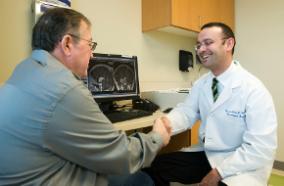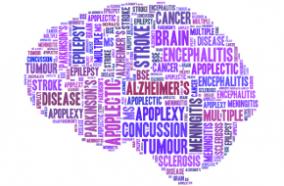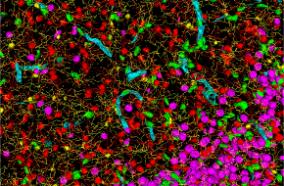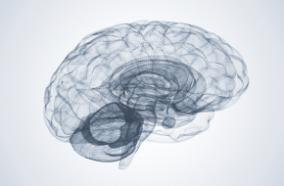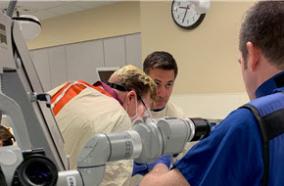1 year 4 months ago
CONCLUSIONS: Completing the Alcohol Symptom Checklist online, typically prior to patient check-in, performed similarly to an in-clinic modality typically administered on paper by a medical assistant at the time of the appointment. Findings have implications for using online AUD symptom assessments to streamline workflows, reduce staff burden, reduce stigma, and potentially assess patients who do not receive in-person care. Whether modality of DSM-5 assessment of AUD differentially impacts...
Theresa E Matson
1 year 4 months ago
Chinese population have a high prevalence of unruptured intracranial aneurysm (UIA). Clinical and imaging risk factors predicting UIA growth or rupture are poorly understood in the Chinese population due to the lack of large-scale longitudinal studies, and the treatment decision for UIA patients was challenging. Develop a decision tree (DT) model for UIA instability, and validate its performance in multi-center studies. Single-UIA patients from two prospective, longitudinal multicenter cohort...
Zheng Wen
1 year 4 months ago
CONCLUSIONS: There were no significant associations between early dexmedetomidine exposure and day 3 brain injury biomarkers in msTBI. Our findings suggest that early dexmedetomidine use is not correlated with either decrease or increase in brain injury biomarkers following msTBI. Further research is necessary to confirm these findings.
Pattrapun Wongsripuemtet
1 year 4 months ago
CONCLUSION: This analysis demonstrates the safety of FESS, as evidenced by acceptable rates of ED utilization, clinic readmission, and revision surgery. Future studies are needed to further elucidate the safety profile of FESS in comparison with traditional spinal procedures.
Jannik Leyendecker
1 year 4 months ago
Pseudomonas aeruginosa is a highly adaptable opportunistic pathogen capable of exploiting barriers and immune defects to cause chronic lung infections in conditions such as cystic fibrosis. In these contexts, host immune responses are ineffective at clearing persistent bacterial infection, instead driving a cycle of inflammatory lung damage. This review outlines key components of the host immune response to chronic P. aeruginosa infection within the lung, beginning with initial pathogen...
Rhea Nickerson
1 year 4 months ago
CONCLUSIONS: Maximal safe resection, including resection and reconstruction of involved sinuses, may be a safe and effective treatment for many patients. Careful preoperative assessment of venous anatomy and planning extent of resection and reconstruction are essential for safe and successful surgery in these patients.
Caroline Hadley
1 year 4 months ago
The 78-kDa glucose regulated protein (GRP78) commonly upregulated in a wide variety of tumors is an important prognostic marker and a promising target for suppressing tumorigenesis and treatment resistance. While GRP78 is well established as a major endoplasmic reticulum (ER) chaperone with anti-apoptotic properties and a master regulator of the unfolded protein response, its new role as a regulator of oncoprotein expression is just emerging. MYC is dysregulated in about 70 % of human cancers...
Vicky Yamamoto
1 year 4 months ago
CONCLUSIONS: In this study, TRA offered comparable outcomes to TFA in MMAE for cSDH in terms of access related and overall complications, technical feasibility, and functional outcomes. Procedural duration was slightly longer in the TRA group, and radiographic success was higher in the TFA group, with no differences in surgical rescue rates.
Mohamed M Salem
1 year 4 months ago
SHORT VEGETATIVE PHASE (SVP), a member of the MADS-box transcription factor family, has been reported to regulate bud dormancy in deciduous perennial plants. Previously, three LcSVPs (LcSVP1, LcSVP2 and LcSVP3) were identified from litchi genome, and LcSVP2 was highly expressed in the terminal buds of litchi during growth cessation or dormancy stages and down-regulated during growth stages. In this study, the role of LcSVP2 in governing litchi bud dormancy was examined. LcSVP2 was highly...
Meng-Meng Ma
1 year 4 months ago
CONCLUSIONS: Undergoing concomitant TVS did not display increased benefit in terms of early or late mortality and RHF in patients with preoperative significant TR. Further data to evaluate the benefit of concomitant TVS stratified by TR severity or by other predictors of RHF will be beneficial.
Bridget Hwang
1 year 4 months ago
CONCLUSION: Bypass indications have evolved with the inception of novel flow diverters. However, they remain relevant in the cerebrovascular surgeon's armamentarium, and long-term results are excellent.
Laligam N Sekhar
1 year 4 months ago
While high circulating tumor DNA (ctDNA) levels are associated with poor survival for multiple cancers, variant-specific differences in the association of ctDNA levels and survival have not been examined. Here we investigate KRAS ctDNA (ctKRAS) variant-specific associations with overall and progression-free survival (OS/PFS) in first-line metastatic pancreatic ductal adenocarcinoma (mPDAC) for patients receiving chemoimmunotherapy ("PRINCE", NCT03214250), and an independent cohort receiving...
Jacob E Till
1 year 5 months ago
CONCLUSIONS: Shunt survival was similar between VA and VPl shunts, although VA shunts are used more often, particularly in younger patients. Children < 6 years with VA shunts appeared to have the shortest shunt survival, which may be a result of the VA group having more cases of IVH secondary to prematurity; however, when age and etiology were included in a multivariable model, shunt location (atrium vs pleural space) was not associated with time to failure. The baseline differences between...
Vijay M Ravindra
1 year 5 months ago
CONCLUSIONS: Preoperative opioid users had increased POD compared to non-opioid users and patients abusing other substances, but there was no difference in LOS. We theorize the lack of difference in LOS may be due to the enhanced perioperative recovery protocol used, which has been demonstrated to reduce LOS.
Luke Castellini
1 year 5 months ago
CONCLUSIONS: Among patients with type 2 MI, prevalence of any CAD and obstructive CAD did not differ according to sex. Total plaque volume was similar between sexes, but women had a lower volume of low-attenuation plaque (DEFINing the PrEvalence and Characteristics of Coronary Artery Disease Among Patients With TYPE 2 Myocardial Infarction Using CT-FFR [DEFINE TYPE2MI]; NCT04864119).
Claire Lin
1 year 5 months ago
No abstract
Irene Camacho
1 year 5 months ago
CONCLUSIONS: MOUD maintenance in jail is strongly associated with MOUD continuity upon release. Still, findings highlight a gap in treatment continuity upon-reentry, especially among those who initiate MOUD in jail. In the wake of worsening overdose deaths and troubling disparities, improving MOUD continuity among this population remains an urgent priority.
Noa Krawczyk
1 year 5 months ago
Cyclic oligonucleotide-based signaling system (CBASS) is an antiviral system that protects bacteria from phage infection and is evolutionarily related to human cGAS-STING immunity. cGAS-STING signaling is initiated by the recognition of viral DNA, but the molecular cues activating CBASS are incompletely understood. Using a screen of 975 type I CBASS operon-phage challenges, we show that operons with distinct cGAS/DncV-like nucleotidyltransferases (CD-NTases) and CD-NTase-associated protein (Cap)...
Desmond Richmond-Buccola
1 year 5 months ago
Toxin-antidote systems are selfish genetic elements composed of a linked toxin and antidote. The peel-1 zeel-1 toxin-antidote system in C. elegans consists of a transmembrane toxin protein PEEL-1 which acts cell autonomously to kill cells. Here we investigate the molecular mechanism of PEEL-1 toxicity. We find that PEEL-1 requires a small membrane protein, PMPL-1, for toxicity. Together, PEEL-1 and PMPL-1 are sufficient for toxicity in a heterologous system, HEK293T cells, and cause cell...
Lews Caro
1 year 5 months ago
CONCLUSION: The long-term clinical results of FE-SJD are favorable. Endoscopic denervation of the dorsal rami branches supplying the sacroiliac joint represents a safe, effective, and durable option to address pain secondary to sacroiliac joint dysfunction. A significant factor that influences outcomes is the presence of concomitant lumbar pathology. Further research is needed to compare this technique with current available treatment options.
Saqib Hasan
"university of washington"[affiliation] and neurological surge...: Latest results from PubMed
More posts about UW Neurological Surgery Recent PubMed Publications

